Fujifilm X-E1 Review
Fujifilm X-E1
The X-E1 takes the X-Pro1 blueprint and makes it smaller and more affordable.
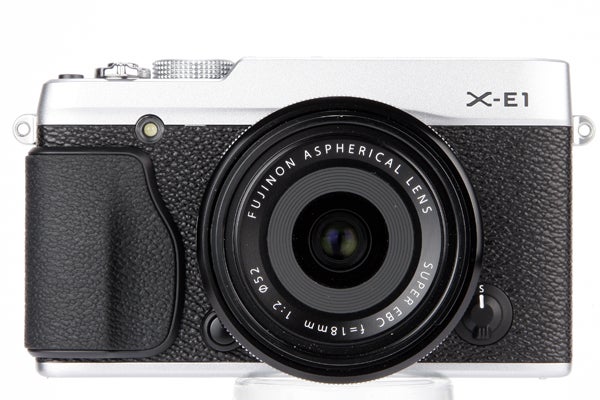
Verdict
Pros
- Stunning image quality
- Premium finish and design
- Excellent electronic viewfinder
- No-nonsense handling
Cons
- AF performance could still be better
- Rear screen not up to standard of rivals
Key Specifications
- Review Price: £1149.00
- 16.3MP APS-C X-Trans CMOS sensor
- ISO 200-6400 (exp. to ISO 100-25,600)
- 1080p Full HD video at 24fps
- 2.8in, 460k-dot LCD display
- 2.44m-dot electronic viewfinder
Fujifilm X-E1: Introduction
Over the past couple of years Fujifilm’s premium quality ‘X’ range has elevated the brand no end in the eyes of enthusiast photographers. The first model in the series – the X100 – combined retro rangefinder looks with a cutting edge ‘hybrid’ viewfinder to great effect, and this was soon followed by the smaller but equally as stylish X10. 
Earlier this year Fuji followed the X100 and X10 up with the launch of
the X range’s first compact system camera – the X-Pro1. With its
rangefinder-inspired design, hybrid viewfinder and proprietary X-Trans
CMOS sensor technology, the X-Pro1 won near universal praise for the
intuitive handling and ultra-sharp image quality it is capable of
producing. That said, as a premium model the X-Pro1 doesn’t come cheap
and even ten months on from its launch the X-Pro1 is still commanding
body-only prices of around £1,180. This is where the X-E1, with its
£730-ish body-only price comes in.
Broadly speaking the X-E1 is aimed at broadening the appeal of Fuji’s X-series CSC range. The X-E1 borrows much from the X-Pro1, but packs it into a slightly smaller and more affordable body. Is this enough to tempt enthusiast photographers? Let’s take a closer look and find out…
Fujifilm X-E1: Features
One of the things that most impressed us about the X-Pro1 was its APS-C sized X-Trans CMOS sensor, and the good news is that the X-E1 uses the very same chip. Fuji’s X-Trans sensor differs from regular CMOS sensors in that it uses a unique colour filter arrangement. While the majority of CMOS sensors employ a traditional Bayer filter array to decode colour information, one inherent problem with the Bayer arrangement is that it produces undesirable aliasing effects such as moiré patterning. This problem has traditionally been solved by placing an anti-aliasing filter in front of the sensor, which eliminates the artefacts but results in a minor loss of critical sharpness. Fuji’s X-Trans sensor, however, uses a unique array of red, green and blue pixels that aren’t arranged in a repetitive order. This allows the sensor to minimize moiré and false colour without the need for an anti-aliasing filter, which in turn delivers noticeably sharper images.
Elsewhere, the XE-1 shares the same dual-core EXR Pro image processor that’s used in the X-Pro1, with a standard ISO range that runs from 200-6400, but which can be further expanded to an ISO equivalent of 100-25,600. Continuous shooting speed clocks in at 6fps, although this can be lowered to 3fps should that be preferable. 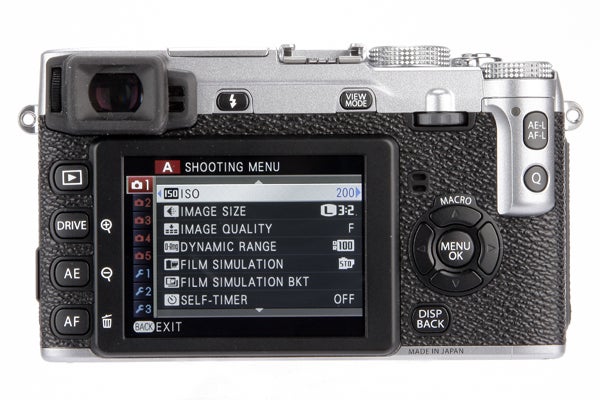
The X-E1 offers JPEG and Raw (.RAF format) capture at various increments up to 16MP, with a maximum output of 4896 x 3264 pixels in the native 3:2 aspect. On top of this the X-E1 also offers a useful Motion Panorama mode, whereby the camera will automatically stitch multiple images together as you pan it in a predetermined direction to produce a single ultra-wide image of up to 7680 x 2160 pixels. Last but not least, the X-E1 can also record video up to a maximum quality setting of 1080p Full HD at 24fps.
Exposure modes extend to the regular manual and semi-manual quartet of Program, Aperture-priority, Shutter-priority and full Manual. As with the X-Pro1, however, there are no built-in digital effects filters although you can choose to shape the look of your images by applying one of the seven Film Simulation modes. In keeping with other Fuji cameras, these aim to replicate the look and feel of old Fujifilm 35mm film stock with, for example, Velvia offering plenty of saturation in contrast to the much more muted Astia. Those looking for a safe middle ground will probably find themselves using the Provia setting more often than not.
As might be expected, the X-E1 uses the same ‘X’ lens-mount as the X-Pro1. At present there are five dedicated X-mount lenses, which are available in the following combinations: 18mm f/2 prime, 35mm f/1.4 prime, 60mm f/2.4 prime, a new 14mm f/2.8 prime and an 18-55mm f/2.8-4 zoom that will be sold as part of a kit from X-series stockists. Given the APS-C dimensions of the X-E1’s sensor all of the aforementioned lenses need to have a 1.5x focal length multiplier applied in order to work out their 35mm focal length equivalent. For example, the 18mm prime offers the same field of view as a 24mm lens would on a full-frame DSLR.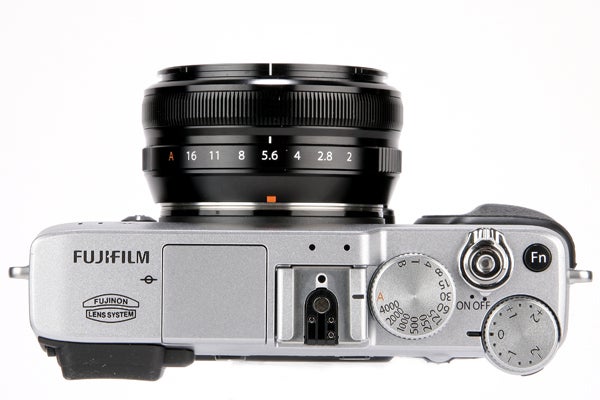
The new 18-55mm kit lens looks to be a smart choice of kit lens. Not only is the build quality very good, but also the relatively fast maximum aperture of f/2.8-4 makes it highly flexible, while the built-in OIS image stabilisation system offers the equivalent of four stops of anti-shake protection. Given the 18-55mm kit zoom’s variable aperture the aperture ring at its base is no longer marked with specific f-stop values. Instead the ring rotates continuously, with each click round representing a third-stop change. A dedicated switch on the side of the lens is used to toggle between Automatic and User-defined aperture control should you want to take direct control over aperture settings in either Shutter-priority or Manual mode.
On the back of the X-E1 you’ll find a fixed 2.8in, 460K-dot LCD monitor. While this is the same that’s found on the X100 it’s somewhat smaller and much less detailed than the 3in/1,230K-dot display used by the X-Pro1. Unlike the X-Pro1 though, the X-E1 does offer a built-in pop-up flash with a GN7 rating. Should you want a little more power then you’ll find a standard hot-shoe on the top-plate that can be used to attach compatible flashguns.
One big difference between the X-Pro1 and the X-E1 is the viewfinder. Whereas the X-Pro1 offers a ‘hybrid’ viewfinder that can be toggled between optical and electronic options, the X-E1’s viewfinder is purely electronic. Thankfully though, Fujifilm has seen fit to improve on the X-Pro1’s 1.44m-dot LCD EVF, fitting the X-E1 with a 2.36m-dot OLED unit instead.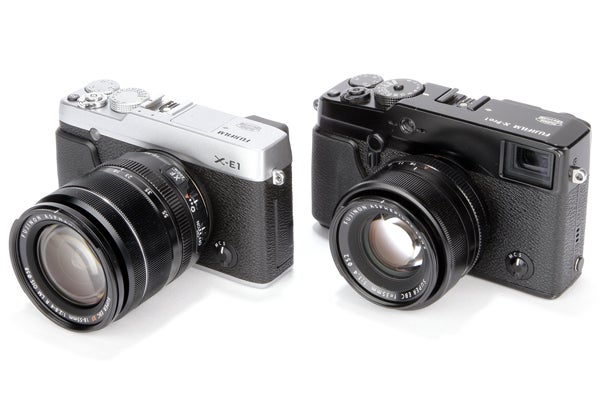
Fujifilm X-E1: Design
In terms of design the X-E1 is an undoubtedly stylish and premium looking camera. Given the lack of an optical viewfinder on the front the X-E1, viewed head-on at least, perhaps looks a little less rangefinder-like than either the X100 or X-Pro1, although the overall aesthetic still borrows heavily from the retro rangefinder camp. Available in black or silver finish, we prefer the more classical look of the silver trim, although the all-black version does also look very sleek and stylish too. 
The X-E1 is noticeably smaller than the X-Pro1, thanks again, at least in part, to the removal of the optical viewfinder. Indeed, in terms of overall size the X-E1 feels more akin to the X100 than the slightly larger X-Pro1. Build quality, as with all of Fuji’s X-series cameras, hasn’t been compromised in any way, with the X-E1 benefiting from a largely die-cast magnesium outer casing and Fuji’s signature faux leather finish, topped off by a good quality rubber grip on the front.
As with the X100 and X-Pro1 before, the X-E1 keeps exposure modes to a minimum, with all of the main shooting controls arranged in a similar way. Shutter speed is controlled via a machined metal dial on the top-plate, while aperture is controlled via the aperture ring on compatible lenses. Should you want to use the camera in either Shutter-priority or Aperture-priority then both the shutter speed dial and all of the X-E1’s dedicated X-mount lenses offer an automatic ‘A’ setting that can be selected to let the camera take control of that aspect. Should you want to shoot in Program mode – the only fully automatic mode offered by the X-E1 – then simply turn both the shutter speed dial and the aperture ring/switch to the ‘A’ position. While most of the X-E1’s main rivals offer a more generous range of fully automated exposure modes (some of which employ advanced scene recognition technology) we have to say that we rather like the X-E1’s old-school approach to shutter/aperture control as it actively encourages you to be more involved and take control of the exposure yourself. For those tricky lighting situations where you need it, you’ll also find an exposure compensation dial on the top plate that offers /-2EV of adjustment. 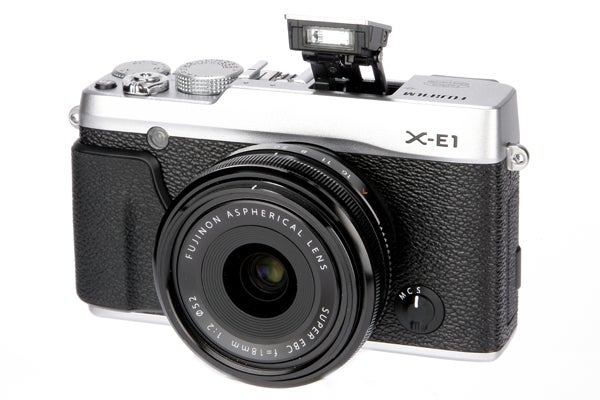
The rest of the X-E1’s physical control layout largely continues on from what’s been seen on the X-Pro1 and X100. The shutter button, for example, has been hollowed out to make it compatible with traditional screw-fit cable releases, even though the X-E1 can also be triggered with an optional RR-80 remote release (£28) if desired. Next to the shutter button you also find a small ‘Fn’ function button that is set to control ISO by default, though this can be customised to control something else via the main in-camera menu.
On the back of the X-E1 button layout is virtually identical to the X-Pro1 used, save for the Playback button moving from the right of the LCD monitor to the left, where it sits above direct-access buttons for the camera’s Drive mode, Metering mode and AF-point selection sub-menus. With the X-E1 set to Playback mode these last three buttons double up as Zoom In, Zoom Out and Delete controls. 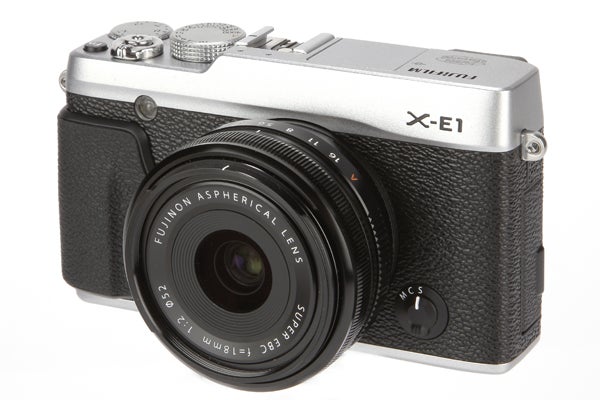
To the right of the monitor you’ll find the 4-way directional pad, along with dedicated Display, Quick Menu and Exposure/AF-lock buttons. A rear control wheel is neatly positioned where your thumb sits and this can be used to change a wide range of settings. Rounding things off is the View Mode selector button that enables you to toggle between the viewfinder and rear screen, although you can also program the eye sensor next to the viewfinder to automatically swap to the EVF when you raise the X-E1 to your eye.
Fujifilm X-E1: Performance
One of the main issues we had with the X-Pro1 was its relatively slow focusing speed. Thankfully the X-E1 improves on this with prompter focusing in single AF, and with only minimal hunting from the 18-55mm lens. That said the X-E1’s overall AF performance still doesn’t quite match what’s on offer from some of its competitors, with models like the Olympus OM-D able to lock focus noticeably faster. And even though the X-E1 isn’t really positioned as a camera for capturing fast-moving action with, the continuous AF does struggle with moving subjects, relying solely on the central AF point for focus.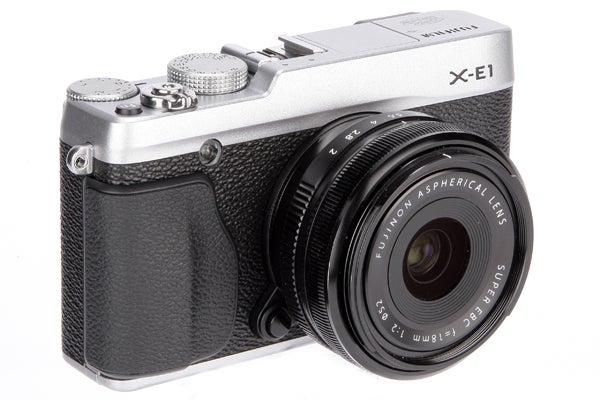
The X-E1’s 49-point AF arrangement does provide good frame coverage, though not to the very edges, and you can also select from five different AF-point area sizes. Manual focusing is fairly intuitive with the image coming into focus pretty quickly as you turn the manual focus ring on the lens. You can also request the camera to display 3x and 10x magnification boxes in either the EVF or the rear screen while the camera is being used in manual focus mode, both of which offer more precise control – especially if you’re using the camera on a tripod.
In use we found that we didn’t really miss the hybrid viewfinder of the X-Pro1 and X100, primarily because the 2.36m-dot resolution of the X-E1’s EVF is a noticeable improvement over the 1.44m-dot EVF used in the X-Pro1. The OLED technology employed by the X-E1’s EVF provides greater levels of contrast too, as well as brighter colours. The payback for the X-E1’s excellent EVF is a somewhat disappointing rear screen, which at 2.8in and 461k-dots doesn’t quite cut it on a camera of this price. It’s still perfectly useable, of course, however it doesn’t deliver quite the same razor-sharp results as a 921k-dot screen would, and for the price we’d really expect to see a higher resolution screen fitted. 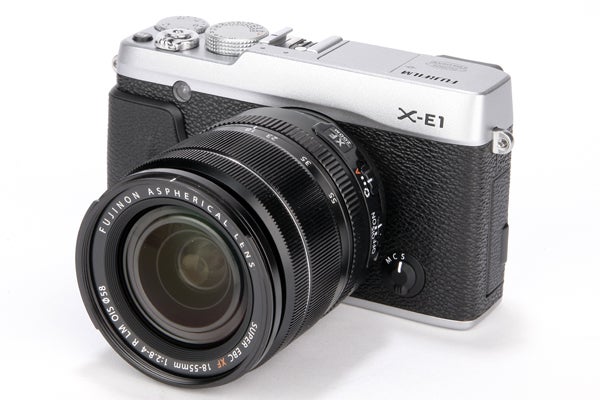
Below are our standardised ISO test shots, starting with the Fujifilm X-E1’s lowest standard setting of ISO 200, going all the way up to 6400, followed by the expanded settings of 12,800 and 25,600.

ISO 200

ISO 200 – 100% crop

ISO 400 – 100% crop
As
well as delivering bags of detail, the X-E1 doesn’t disappoint when it comes to
ISO performance either. Up to ISO 800 images are smooth and devoid of any unwanted signs
of image noise.

ISO 800 – 100% crop
At ISO 800 noise beginning to encroach ever-so slightly at ISO 800, but
it’s very subtle.
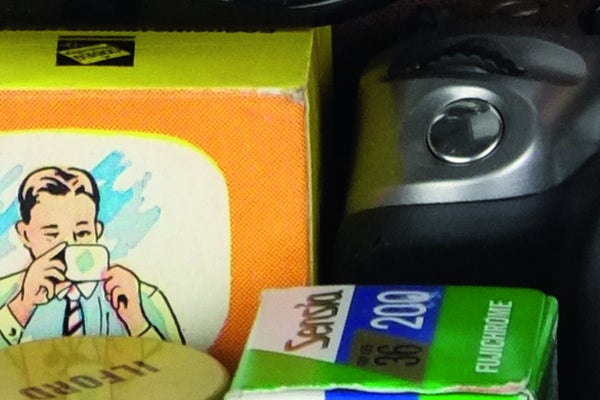
ISO 1600 – 100% crop

ISO 3200 – 100% crop
While
image noise does become more apparent at ISO 3200, the level of detail rendered
is still good.

ISO 6400 – 100% crop
At
ISO 6400, results are still far more than acceptable, and though image noise is
apparent, has a pleasing film-like structure

ISO 12,800 – 100% crop
Detail
suffers at the extended ISOs of 12,800 and 25,600 with chroma noise becoming
more prominent.

ISO 25,600 – 100% crop

1/1000sec @ f/11, ISO 800, 80mm

1/350sec @ f/10, ISO 800, 24mm

1/500sec @ f/11, ISO 400, 24mm

1/100sec @ f/11, ISO 400, 46mm

1/60sec @ f/6.4, ISO 400, 45mm
Fujifilm X-E1: Image Quality
The X-E1 uses the same 256-zone
metering system as the X-Pro1, providing Multi, Spot and Average
metering modes. With Multi metering selected, the X-E1 delivers
well-exposed shots in almost every situation. Occasionally a dab of
positive exposure compensation is required, however given that the EV
exposure dial falls within easy reach it’s pretty easy to apply. 
The
X-E1 benefits from two expanded dynamic range settings, which are
referred to as DR200 and DR400. The aim of these two settings is to
retain highlight information, which can be an issue when shooting
high-contrast scenes. Working with both JPEGs and Raw files, shooting in
DR200 does see the X-E1’s base ISO increase to ISO 400, while ISO 800
will be your base ISO if shooting in DR400, however the results are
impressive, with considerable highlight detail retained.
Automatic
white balance is consistent in both natural and artificial light,
producing neutral, pleasingly saturated results throughout the ISO
range. With a nod to Fuijfilm’s 35mm film stock heritage, the X-E1 offer
a range of Film Simulation modes that can be called upon to provide a
slightly different look to your images, with Velvia, Provia, Astia, Pro
Neg.Std, Pro Neg.Hi. With the aid of the bracketing tool it’s also
possible to bracket three different Film Simulation effects for each
image so that you can choose which you prefer afterwards. 
As
with the X-Pro1 before it, the sharpness and level of detail delivered
by the X-E1 is nothing short of spectacular. The unique colour pattern
array of the X-E1’s proprietary X-Trans CMOS sensor has allowed Fuji to
remove the anti-aliasing filter which, in turn, allows the X-E1 to
capture a level of detail that surpasses other APS-C based cameras with a
similar resolution.
Comparing Raw files side-by-side with JPEG
images we were surprised to find that they’re both fairly evenly
matched when it comes to detail at base ISOs, although the Raw file
still has the edge here. As sensitivity is increased, Raw files appear
to have more ‘bite’, with JPEG files becoming progressively smoother due
to the in-camera noise reduction. Overall though, the X-E1’s JPEG
processing is very pleasing.
Fujifilm X-E1: Verdict
While
it might be tempting to think of the X-E1 as a stripped back X-Pro1,
that does it something of a disservice in that the X-E1 is a great
camera in its own right. Gifted with the same premium grade construction
and finish, the X-E1 feels more refined and balanced than it’s more
expensive sibling. While some may lament the removal of the hybrid
viewfinder found in the X-Pro1, the truth is that the X-E1’s sharper,
crisper EVF more than makes up for this, though the rear screen remains,
at 2.8in and 460k-dots, somewhat underpowered for a camera of this
price. Our only other issue is the autofocus performance and while this
has certainly been improved from the X-Pro1, it’s still not as fast or
as responsive as what’s offered by other CSCs. These issues aside, and
the X-E1 is a joy to shoot with. By far the biggest selling point of the
X-E1, however, is its sensor. The quality of the results and the detail
rendered is excellent, delivering images that are some of, if not the
best we’ve seen from an APS-C sized sensor.
Trusted Score
Score in detail
-
Value 8
-
Design & Features 8
-
Image Quality 10
-
Build Quality 10

